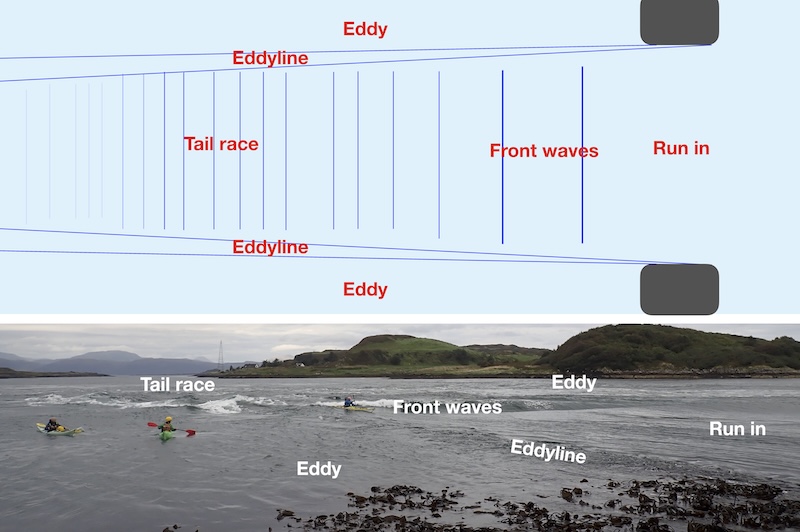3.4 Wind, waves and tidal streams
In some areas of the coastline, the tidal stream is faster than others, as we looked out in the notes on tidal streams. As a reminder this can be due to:
Headlands that stick out into the stream and squeeze it sideways - a tide race
Shallow areas that squeeze the flow vertically - an overfall
Both effects happening at the same time - as often happens at headlands that end in shallow areas
3.4.1 Wind and waves against tide
People often talk about ‘wind against tide’ causing a rough sea. In reality, it is the waves created by the wind interacting with the tidal stream that causes rough conditions. It is good to remember that this can happen with any waves - so a race can be rough when there is no wind, but a swell is present.
When waves are going the opposite direction to a tidal stream, they become shorter, taller and often break. This can make for challenging (scary / fun) conditions in tide races and overfalls.

Photograph of the tide race at Penrhyn Mawr. Contrast the smooth eddy in the foreground with the rough water in the tidal stream (going left to right).
Let’s dig into more detail as to why this happens by following some waves from still water into a tide race.

At (A) the waves are in still water, moving from the left hand side of the image towards the right. The tidal stream increases towards the right hand side of the image. As the waves enter the faster stream, they’re squeezed together (B), reducing their wavelength. This has several effects:
The waves become steeper. They may well become so steep that they break.
The wave energy becomes concentrated into a smaller area, so the waves get higher.
The waves slow down.
The waves continue to slow down until they reach a point where they can no longer travel upstream (C). This point is sometimes called the ‘stop line’. Above this point, in the run in to the race (D), there are no waves and the water can be flat.
Of course, in reality, the sea state is rarely a single simple swell like we’ve just looked at. Instead, waves come in many different periods and sizes. Waves of each period will have a different stopping speed and hence will stop at a different point in the race as the flow accelerates. The result is that:
In the lower, slower, part of the race, many wave periods are present. The waves are all being compressed and steepened, so the result is a chaotic mess of breaking waves
As we move up the race, only the fastest waves (longest wavelengths) are left. As a result, the front waves of the race are much more regular and ‘clean’ - this is the best part of the race to surf
Above the front waves, in the ‘run in’ the race may continue to accelerate to a speed greater than the stopping velocity of any of the waves. None of the waves can penetrate onto this fast flow, so the water surface will be smooth. The smooth water may continue above the race when the flow speed decreases.
If we look at a race, we can often see these features. The image below shows an idealized diagram of a race and a picture of a small race.

Here we can see the smooth run-in, which no waves can penetrate into and the ordered waves at the front of the race. Further down in the ‘tail race’, the waves are smaller, but more disordered. To make it possible to see all this, I’ve chosen a small race for the image - often these features will be present over a much bigger area.
Actually, there are a number of factors that often contribute to a tide race being rough:
The waves are compressed by the flow, becoming shorter in wavelength and much steeper - and often breaking
The concentration of wave energy into a smaller wavelength causes the wave height to increase, making the waves steeper still
Refraction occurs at the edges of the flow (the part of the wave in the slower water can travel faster, so the wave turns into the flow), concentrating and containing the waves in the strongest flows
Waves with initial (still water) speeds less than 4 times the flow speed are stopped by the flow, and can be reflected back down the race, increasing the chaos
Sometimes, we see waves (and/or wind creating waves) that move in the same direction as the tidal flow. When this happens, the waves get stretched out by the flow, and the sea can be very calm.